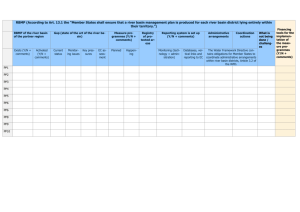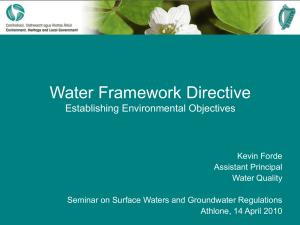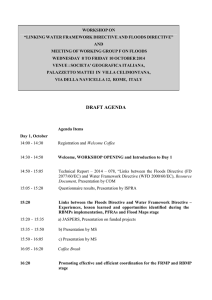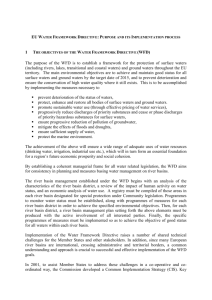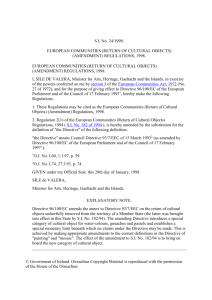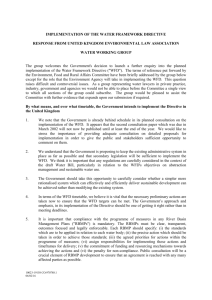Described as the most significant piece of water legislation
advertisement
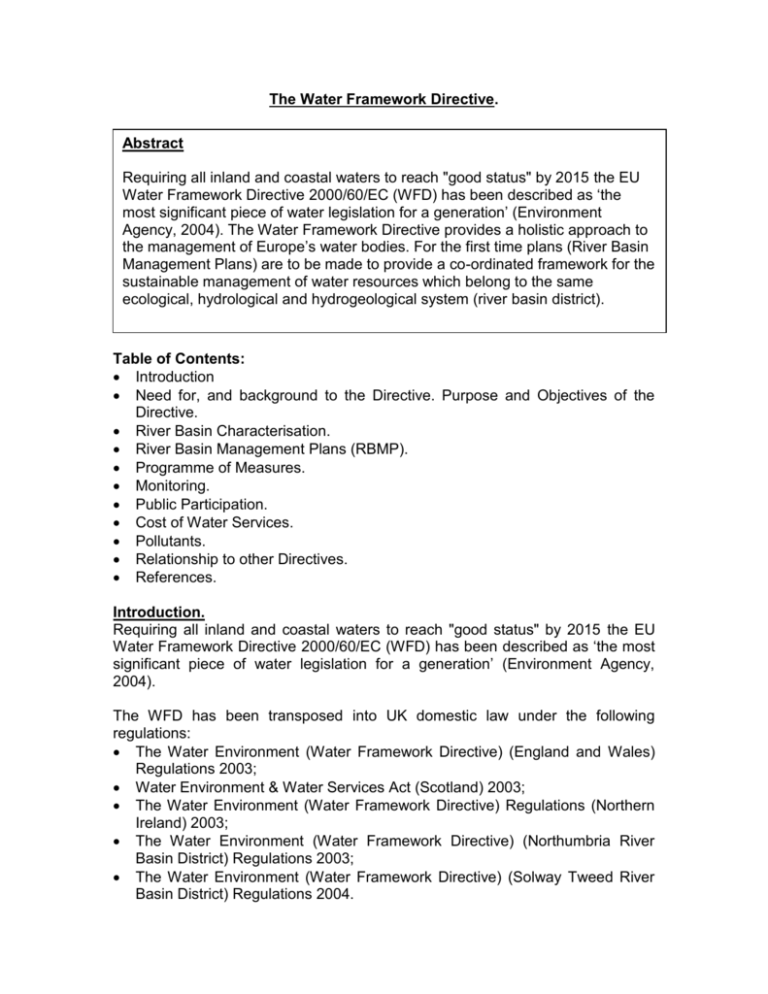
The Water Framework Directive. Abstract Requiring all inland and coastal waters to reach "good status" by 2015 the EU Water Framework Directive 2000/60/EC (WFD) has been described as ‘the most significant piece of water legislation for a generation’ (Environment Agency, 2004). The Water Framework Directive provides a holistic approach to the management of Europe’s water bodies. For the first time plans (River Basin Management Plans) are to be made to provide a co-ordinated framework for the sustainable management of water resources which belong to the same ecological, hydrological and hydrogeological system (river basin district). Table of Contents: Introduction Need for, and background to the Directive. Purpose and Objectives of the Directive. River Basin Characterisation. River Basin Management Plans (RBMP). Programme of Measures. Monitoring. Public Participation. Cost of Water Services. Pollutants. Relationship to other Directives. References. Introduction. Requiring all inland and coastal waters to reach "good status" by 2015 the EU Water Framework Directive 2000/60/EC (WFD) has been described as ‘the most significant piece of water legislation for a generation’ (Environment Agency, 2004). The WFD has been transposed into UK domestic law under the following regulations: The Water Environment (Water Framework Directive) (England and Wales) Regulations 2003; Water Environment & Water Services Act (Scotland) 2003; The Water Environment (Water Framework Directive) Regulations (Northern Ireland) 2003; The Water Environment (Water Framework Directive) (Northumbria River Basin District) Regulations 2003; The Water Environment (Water Framework Directive) (Solway Tweed River Basin District) Regulations 2004. The Department for Environment, Food and Rural Affairs (DEFRA) has identified two main government roles: - the “appropriate authority” role and the “Agency” role (table 1). Role Responsible Authority / Agency “appropriate General responsibility for ensuring the England: the Secretary of authority” Directive is given effect and has to State approve environmental objectives, Wales: the National programmes of measures and river basin Assembly for Wales management plans (DEFRA, 2004). Scotland: the Scottish . Ministers Northern Ireland: the Department of the Environment. (DEFRA, 2004). “Agency” Responsibility England: the Characterise river basin districts; Environment Agency. Identify bodies of water used for the Wales: Environment abstraction of drinking water; Agency. Prepare, review and keep up to date a register of protected areas for each Scotland: the Scottish Environment Protection river basin district; Agency. Establish programmes to monitor Northern Ireland: the water status, so as to establish an Department of the overview of water status within each Environment river basin district; (DEFRA, 2004). Prepare and submit to the ‘appropriate authority’ (e.g. Secretary of State and/or National Assembly for Wales) environmental objectives for each body of water and programmes of measures; Prepare and submit to the appropriate authority a river basin management plan for each district (including consultation, publicity and taking account of views) and supplementary plans (EA, 2004). Table 1: Roles, Responsibilities, Authorities and Agencies. Need for, and background to the Directive. European water legislation began in 1975 with quality standards for rivers and lakes used for drinking water abstraction. In 1980 binding drinking water quality targets were set. Other legislation included quality objectives on fish waters, shellfish waters, bathing waters and groundwaters. The main emission control element was the Dangerous Substances Directive (EU, 2004). In 1988 the Council asked the Commission to submit proposals to improve ecological quality in Community surface waters. In 1991 the following legislation was adopted: the Urban Waste Water Treatment Directive; the Nitrates Directive. Whilst, the above Directives tackled individual issues they were fragmented in terms both of objectives and the means/methods applied to achieving the objectives. In recognition of ‘the need for action to avoid long-term deterioration of freshwater quality and quantity’ the Ministerial Seminar on groundwater held in 1991 called for a programme of actions aimed at sustainable management and protection of freshwater resources to be implemented by the year 2000 (EC, 2000). The Commission presented a Proposal for a Water Framework Directive with the following key aims: expanding the scope of water protection to all waters, surface waters and groundwater achieving "good status" for all waters by a set deadline water management based on river basins "combined approach" of emission limit values and quality standards getting the prices right getting the citizen involved more closely streamlining legislation The resulting EU Water Framework Directive was adopted on 23 October 2000 and came into force on 22 December 2000. Purpose and Objectives of the Directive. Whilst recognising that ‘Waters in the Community are under increasing pressure from the continuous growth in demand for sufficient quantities of good quality water for all purposes’ the purpose of the Directive is primarily concerned with water quality. However, quantity and quality are linked and the WFD recognises that control of quantity is an important element in securing good water quality. Article 1 states: ‘The purpose of the WFD is to establish a framework for the protection of inland surface waters, transitional waters, coastal waters and groundwater which: prevents further deterioration, protects and enhances the status of aquatic ecosystems; promotes sustainable water use; aims at enhanced protection and improvement of the aquatic environment; ensures the progressive reduction of pollution of groundwater and prevents its further pollution, and contributes to mitigating the effects of floods and droughts. Table 2 summarises the basic objectives of the WFD as stated in Article 4(1): Surface Waters Groundwater Protected areas prevent deterioration in the status of surface water bodies protect, enhance and restore all bodies of surface water with the aim of achieving good surface water status by 2015 protect and enhance all artificial and heavily modified bodies of water, with the aim of achieving good ecological potential and good surface water chemical status by 2015 progressively reducing pollution from priority substances and ceasing or phasing out emissions, discharges and losses of priority hazardous substances. prevent or limit the input of pollutants into groundwater and to prevent the deterioration of the status of all bodies of groundwater protect, enhance and restore all bodies of groundwater, ensure a balance between abstraction and recharge of groundwater, with the aim of achieving good groundwater status by 2015 prevent or limit the input of pollutants to groundwater and reverse any significant and sustained upward trend in the concentration of pollutants in groundwater comply with European wide measures against priority and priority hazardous substances achieve compliance with any relevant standards and objectives for protected areas Table 2: Summary of WFD objectives. River Basin Characterisation. By June 2004 Member States are required to identify the individual river basins lying within their national territory and assign them to individual river basin districts (RBD). The WFD covers all the following water bodies which will occur within each RDB: Surface freshwater bodies, whether natural or artificial (including lakes, streams and rivers); Groundwaters; Transitional waterbodies (estuaries); and Coastal waters out to 1mile from low-water. For each RBD the WFD requires: An analysis of its characteristics; A review of the impact of human activity on the status of the water bodies; and An economic analysis of water use. By December 2004 a characterisation report for each RBD should be made. The aim of the characterisation report is to describe and provide a better understanding on the current and predicted future state of aquatic environments. The report should identify and record: areas designated as requiring special protection under specific Community legislation. all bodies of water used for the abstraction of water intended for human consumption providing more than 10 m3 a day as an average or serving more than 50 persons, and those bodies of water intended for such future use. The information within the report should be used to: set appropriate environmental objectives; target monitoring efforts towards those water bodies at greatest risk of failing to meet their stated objectives; and establish programmes of measures to ensure water bodies reach the environmental objectives. River Basin Management Plans (RBMP). The WFD sets out organisational and procedural aspects of water management. Central to these are RBMPs which should provide a co-ordinated framework for the sustainable management of water resources which belong to the same ecological, hydrological and hydrogeological system (river basin district). The WFD requires that a RBMP is produced for each RBD by December 2009 and reviewed and updated by 2015 and every six years thereafter. Detailed analysis of the pressures on the water bodies within each river basin and an assessment of their impacts will inform the plans. The plan is a detailed account of how the objectives set for the river basin (ecological status, quantitative status, chemical status and protected area objectives) are to be reached within the timescale required (EU, 2004). The RBMP shall include the information detailed in Annex VII of the WFD, including: a general description of the characteristics of the river basin district; a summary of significant pressures and impact of human activity on the status of surface water and groundwater; identification and mapping of protected areas; a map of the monitoring networks established; a list of the environmental objectives for all the water bodies within each river basin; a summary of the economic analysis of water use; a summary of the programme or programmes of measures adopted; a register of any more detailed programmes and management plans for the river basin district; a summary of the public information and consultation measures taken, their results and the changes to the plan made as a consequence; a list of competent authorities; and the contact points and procedures for obtaining the background documentation and information. Programme of Measures. A programme of measures is to be prepared for each individual RBD by 2009, and to be operational by 2012. Each programme should include the following basic measures and, where necessary, "supplementary" measures: measures required to implement Community legislation for the protection of water; measures to promote efficient and sustainable water use; controls over the abstraction of fresh surface water and groundwater, and impoundment of fresh surface water; controls on the artificial recharge or augmentation of groundwater bodies; controls for point source discharges liable to cause pollution; measures to prevent or control the input of pollutants where diffuse sources are liable to cause pollution; a prohibition of direct discharges of pollutants into groundwater (with exemptions); measures to eliminate pollution of surface waters by those substances specified in the list of priority substances and to progressively reduce pollution by other substances; any measures required to prevent significant losses of pollutants from technical installations, and to prevent and/or to reduce the impact of accidental pollution incidents for example as a result of floods. Monitoring. Member states are required to establish water status monitoring programmes for surface waters, groundwaters, wetlands and protected areas within each RBD by 2006 (table 3): Surface waters Ground waters Protected areas The volume and level or rate of flow. The ecological and chemical status and ecological potential. Monitoring of the chemical and quantitative status. To be supplemented by the specifications contained in Community legislation under which the individual protected areas have been established. Table 3: Monitoring requirements. Through its protected areas provisions the WFD also incorporates the remaining existing water Directives into its framework: Council Directive 76/160/EEC on Bathing Water Quality, Directive 91/676/EEC on nitrates from agricultural sources; Directive 91/271/EEC on Urban Waste Water Treatment and Directive 98/15/EEC amending directive 91/271/EEC. Public Participation. The WFD requires Member States to encourage the active involvement of all interested parties in the implementation of the Directive, in particular in the production, review and updating of the river basin management plans. For each river basin district the following should be made available to the public for comment: a timetable and work programme for the production of the plan, including a statement of the consultation measures to be taken; an interim overview of the significant water management issues identified in the river basin; draft copies of the river basin management plan. Cost of Water Services. The WFD recognises the impact that individual households, industry and agriculture use of water services has upon achieving the objectives of the Directive. Article 9(1) requires Member States to develop means by which the costs of water services shall reflect the environmental and resource costs in accordance with the polluter pays principle. The WFD requires that by 2010 Member States shall ensure that water-pricing policies provide adequate incentives for users to use water resources efficiently and thereby contribute to the environmental objectives of the Directive. Water-pricing policies should ensure an adequate contribution of the different water uses, disaggregated into at least industry, households and agriculture, to the recovery of the costs of water services taking account of the polluter pays principle. Pollutants. In relation to polluting substances the WFD aims to achieve the elimination of Priority Hazardous Substances and to contribute to achieving concentrations in the marine environment of near background values for naturally occurring substances. The Dangerous Substances Directive (76/464/EEC) will be repealed with the WFD requiring member states to cease discharges, emissions and losses of certain priority hazardous substances. By 2012 Member States shall establish and/or implement emission controls based on best available techniques, the relevant emission limit values, and (in the case of diffuse impacts) the best environmental practices set out in the relevant Council Directives. As well as prevention at source, the Directive sets a framework for water management and the setting of environmental objectives for water bodies including chemical status for both surface water and groundwater. The establishment and implementation of a programme of measures (including preventing inputs from point sources, diffuse sources and accidents) is required to achieve these objectives for each RBD. Relationship to other Directives. The WFD rationalises and updates existing water legislation, introducing an integrated and co-ordinated approach to water management based on the concept of river basin planning. Table 3 summarises the EC Directives that will be repealed (table 4): Repealed seven years after the date of entry into force of this Directive (2007). Council Directive 75/440/EEC concerning the quality required of surface water intended for the abstraction of drinking water in the Member States. Council Decision 77/795/EEC establishing a common procedure for the exchange of information on the quality of surface freshwater in the Community. Council Directive 79/869/EEC concerning the methods of measurement and frequencies of sampling and analysis of surface water intended for the abstraction of drinking waters in the Member States. Repealed thirteen years after the date of entry into force of this Directive (2013): Council Directive 78/659/EEC on the quality of freshwaters needing protection or improvement in order to support fish life. Council Directive 79/923/EEC on the quality required of shellfish waters. Council Directive 80/68/EEC on the protection of groundwater against pollution caused by certain dangerous substances. Council Directive 76/464/EEC on pollution caused by certain dangerous substances discharged into the aquatic environment of the Community (with the exception of Article 6). Table 4: Directives to be repealed. The Habitats and Birds Directives are linked to the WFD. Conservation sites (SACs and SPAs) with water related interest features identified under the Habitats Directive and Birds Directive will be designated as Protected Areas under the WFD. References 1. Department for Environment, Food and Rural Affairs (DEFRA), 2004, Water Framework Directive, http://www.defra.gov.uk/environment/water/wfd/, accessed 6/9/04. 2. European Parliament and Council of the European Union (2000), Directive 2000/60/EC of the European Parliament and of the Council of 23 October 2000 establishing a framework for Community action in the field of water policy, Commission of the European Communities, Brussels. 3. European Union (2004), Introduction to the new EU Water Framework Directive, http://europa.eu.int/comm/environment/water/waterframework/overview.html, accessed 6/9/04.
